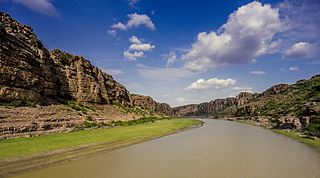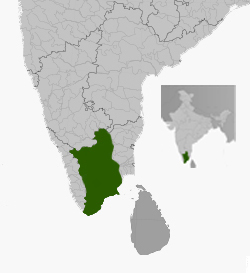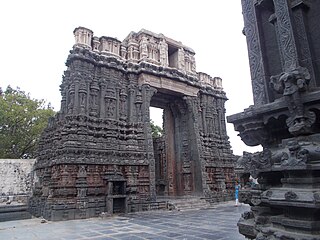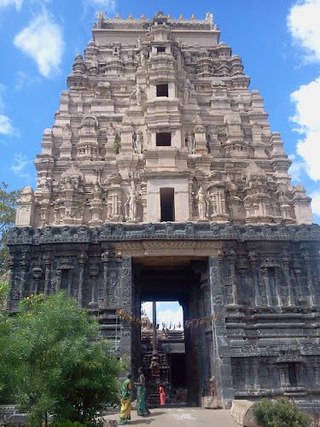Kamma is a Hindu caste from South India. The community of Kammas is believed to have originated from agriculturists of the Kammanadu region of the Guntur and Prakasam districts in Andhra Pradesh. Propelled by their military activity in the Vijayanagara Empire, Kammas are believed to have spread out from the region during the Vijayanagara period, followed by some in-migration during the British period and out-migration again during the twentieth century. Today they are regarded as the richest group in Andhra Pradesh and are a dominant caste from Coastal Andhra with socio-economic and political prominence throughout the Telugu-speaking regions of India.
Naidu (Nayudu/Nayadu/Naidoo/Nayakudu) is a title used by some South Indian Telugu communities, Telugu people such as the Balija, Golla, Kamma, Kapu, Gavara, Telaga, Turupu Kapu, Ekila Kapu(Pala Ekari), Velama, Boya and Yadava Naidu.

Krishnadevaraya was an emperor of the Vijayanagara Empire, also known as the Karnata Empire, reigning from 1509 to 1529. He was the third monarch of the Tuluva dynasty, and is considered to be one of the greatest rulers in Indian history. He ruled the largest empire in India after the decline of the Delhi Sultanate. Presiding over the empire at its zenith, he is regarded as an icon by many Indians. Krishnadevaraya earned the titles Karnatakaratna Simhasanadeeshwara, Yavana Rajya Pratistapanacharya, Kannada Rajya Rama Ramana, Andhra Bhoja, Gaubrahmana Pratipalaka and Mooru Rayara Ganda. He became the dominant ruler of the peninsula by defeating the sultans of Bijapur, Golconda, the Bahmani Sultanate and the Gajapatis of Odisha, and was one of the most powerful Hindu rulers in India.

Rama Raya was a statesman of the Vijayanagara Empire, the son-in-law of Emperor Krishna Deva Raya and the progenitor of the Aravidu dynasty of Vijayanagara Empire, the fourth and last dynasty of the empire.

Penukonda also called Penugonda is a town in the Sri Sathya Sai district of Andhra Pradesh, India. It is 70 km away from Anantapur town.
Nayaka dynasties emerged during the Kakatiya dynasty and the Vijayanagara Empire period. The Nayakas were originally military governors under the Vijayanagara Empire. After the battle of Talikota, several of them declared themselves independent.

Gandikota is a village and historical fort on the right bank of the Penna river, 15 km from Jammalamadugu in Kadapa district, Andhra Pradesh, India. The fort was the centre of power for various dynasties, such as the Kalyani Chalukyas, Pemmasani Nayakas, and the Golconda Sultanate. Gandikota was the capital of Pemmasani Nayakas for more than 300 years. Pemmasani Ramalinga Nayudu constructed the huge fort at Gandikota with 101 towers replacing the previous sand fort constructed by Kaka Raja, Vassals of Kalyani Chalukya rulers. Various additions of Islamic architecture were made during subsequent Muslim rule.

Tadipatri or Tadpatri is a city in Anantapur district of the Indian state of Andhra Pradesh at the border of Kurnool district and Kadapa district. It is the mandal headquarters of Tadipatri mandal in Anantapur revenue division. The Chintala Venkataramana Temple is located on a five acre site in Tadipatri. The Bugga Ramalingeswara Temple is located one kilometer from the town, overlooking the Penna River.
Pemmasani Nayaks were a ruling clan in the south Indian state of Andhra Pradesh. They came into prominence during Vijayanagara times as rulers of Gandikota over 300 years. After the Battle of Talikota in 1565 AD, the collapse of Vijayanagara Empire led to the emergence of Pemmasani Nayakas in the Rayalaseema region. They belonged to the Kamma social group.

The Battle of Raichur was a battle fought between the Vijayanagara Empire and the Sultanate of Bijapur in 1520 in the town of Raichur, India. It resulted in a decisive victory for Vijayanagara forces, and the Bijapur ruler was defeated and pushed across the river Krishna.

The Madurai Nayaks were rulers of Telugu origin from around 1529 until 1736, of a region comprising most of modern-day Tamil Nadu, India, with Madurai as their capital. The Nayak reign was an era noted for its achievement in arts, cultural and administrative reforms, revitalization of temples previously ransacked by the Delhi Sultans, and the inauguration of a unique architectural style.
Pemmasani Timmanayudu I, also known as Thimma Nayudu, was the progenitor of the Pemmasani Nayaks, as per the kaifiyat of Tadipatri. The Pemmasani migrated from Telugu regions to serve the Vijayanagara Empire militarily.
Pemmasani Ramalinga Nayudu is named as a commander and 'chief general' of the Vijayanagara emperor Krishnadevaraya in the 17th century Telugu text Rayavachakamu, and a later poetic rendition Krishnarajavijayam.

Mikkilineni Radhakrishna Murthy was an Indian actor and thespian known for his works predominantly in Telugu cinema. He was the founder of the theater group Praja Natya Mandali. He has received the honorary Kalaprapoorna from Andhra University, for his contributions towards Telugu theater and cinema.

Bugga Ramalingeswara Swamy temple is a Siva shrine situated on the southern bank of the Penna river in Tadipatri, Anantapur district of Andhra Pradesh, India. It was built between 1490 and 1509 by Pemmasani Ramalinga Nayudu I, a Pemmasani Nayaka chieftain of the Gutti-Gandikota region during the reign of the Vijayanagara Empire.

Chintalarayaswamy Temple or Sri Chintala Venkataramana Temple is a Hindu Vaishnavite temple situated at Tadipatri, a town in the Anantapur District of Andhra Pradesh, India. The Temple is dedicated to Venkateswara, a form of Vishnu, who is referred to as Chintala Venkataramana. The temple was built by Pemmasani Timmanayudu II of the Pemmasani Nayaks. It is situated on the bank of the Penna River, which passes through the town. The temple has granite sculptures and is classified as one of the Monuments of National Importance by Archaeological Survey of India (ASI). The temple has a Garuda Mandapa built as chariot with rotating granite wheels, which is similar to the one found in the Vithala Temple of Hampi.

Pemmasani Ramalinga Nayudu I was a member of the Pemmasani Nayak clan in the 15th century Vijayanagara Empire in southern India. He developed the hamlet of Tallapalle, renaming it to Tadipatri upon orders of the Vijayanagara emperor. He built a fort in the town and the Bugga Ramalingeswara Temple. Another temple to Obaleswara in Kurnool District is also attributed to him.

Pemmasani Timmanayudu II was a member of the Pemmasani Nayaks. He was the son of Pemmasani Ramalinga I and a contemporary of Vira Narasimharaya and Krishnadevaraya. After the death of his father, Timmanayudu went to inform the Vijayanagara Emperor of the progress made in developing the Rayalaseema region. The emperor was so pleased with what he heard that he made Timmanayudu the commandant of the Gandikota Fort on behalf of Saluva Govindaraja, its governor. Then, Timmanayudu gave control of Yadiki and Tadipatri, which were previously controlled by his ancestors, to a relative and shifted to Gandikota.